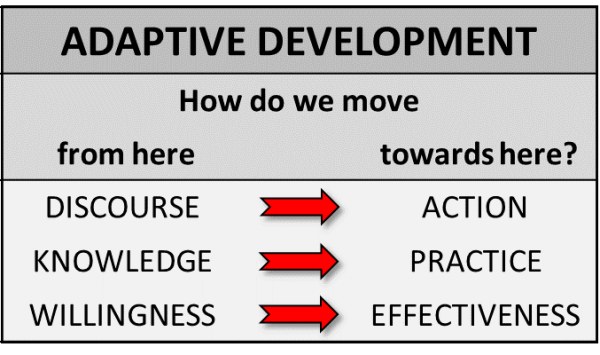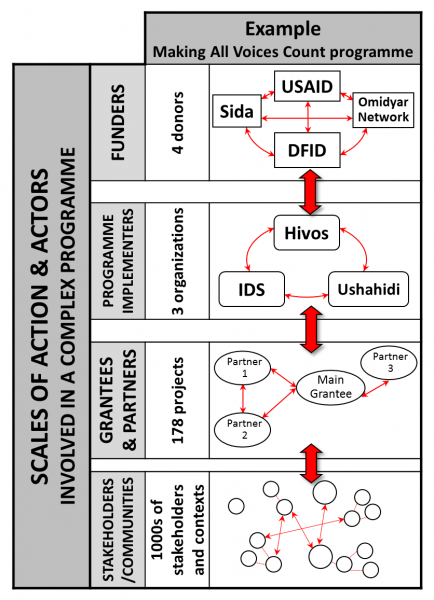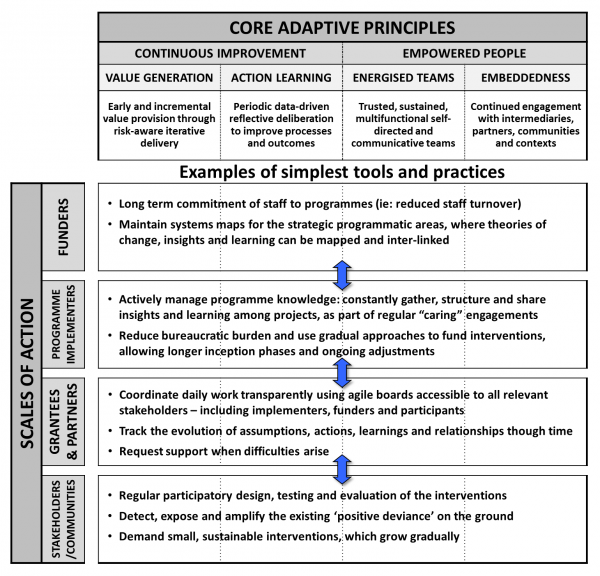In recent years, more and more influential development organisations have been openly recognising the central role that adaptive management capacities – the ability to keep improving strategies and actions as programmes unfold – play for the success of complex interventions. As a result, there has been a rich exchange of ideas and experiences on how to promote adaptiveness in development.
But development organisations and professionals are having a hard time translating the many adaptive theories and recommendations into improved practices and outcomes. They are generally failing to adjust the design and operation of programmes to accommodate incipient lessons learnt and the unexpected changes in the context. Nowadays, most programme adaptations still take the form of a change of direction once it is clear that things have gone really wrong.
Why is so difficult to put what we know about adaptiveness into practice? And more importantly: what can be done to improve this situation?

Our research project Doing Digital Development Differently? investigated how various tech-for-governance initiatives in Kenya learned from and adapted to unanticipated challenges. All the initiatives faced important challenges which compelled them to adapt in one way or another —and they did it brilliantly, in many cases!
Most of our informants, however, shared with us a deep frustration arising from their failure to foresee the challenges, and their limited capacity to confront them. Many projects suffered from important disconnections between the project’s design and its execution: a design–reality gap which operated at various levels, ranging from technical challenges, to having wrong expectations about stakeholders and users, to theories of change not adequately rooted in the realities of the context.
Our interviewees agreed on the need to remain flexible, muddle through difficulties and keep adapting, and many were familiar with adaptive concepts and frameworks. But these were not consistently applied: the lack of flexibility imposed by the dominating – very hierarchical – accountability models, and a failure to proactively capture and disseminate learning meant that insights obtained during a project could only be applied – if at all – to future initiatives, not to the current work. Very often, as The Engine Room’s analysis of Making All Voices Count’s research on the design and use of tech suggests, “when things go wrong it’s game over for the project”.
What’s more: we found that this lack of adaptive capacity affects not only grantees that run small and middle-sized projects. Implementing organisations that execute big multi-year programmes – like Making All Voices Count – as well as the donors that commission them, also experience serious difficulties in learning and adapting.
In fact, our research showed that adaptiveness is a relational capacity. It emerges through time from the vertical and horizontal collaborative interactions that connect the many stakeholders involved in a development intervention at different scales of action; as this diagram shows, for a programme like Making All Voices Count, these interactions are complex.

Each stakeholder plays a role as an enabler – or disabler – of the adaptive capacity of those other actors operating under its oversight. And conversely: successful adaptations an actor makes come to reinforce the adaptive capacity of their partners and of those working at higher levels.
So… what can we do to learn and adapt better?
In a sector so fond of evaluations, reports and recommendations, one important problem that practitioners and development organisations face is that there are way too many adaptive frameworks and prescriptions competing for their attention, making it difficult for them to know what to do or where to start. To avoid contributing even more to this confusion, we want to share just the most essential idea which emerged from our research, summarised in three simple insights and schematised in one diagram:
-
Practice... makes adaptive!!
It’s easier to act your way into adaptive thinking than to think your way into adaptive acting. This is because the solutions to complex problems cannot be achieved just through pure determination or deep reflection and planning: solutions emerge gradually, out of a process of sustained engagement with the problem.
Software development teams, for example, who use agile methods to create complex technologies, do not ever theorise about a thing called ‘adaptation’. They just make use, on a daily basis, of really simple tools and practices, which enable them to interact better with each other, learn faster, focus on the important work, and thus accelerate value delivery.
Programmes addressing complex developmental problems should worry less about grand adaptive concepts and frameworks, and focus instead on establishing such sets of ‘simplest tools and practices’ (ST&P) that match the different scales of action involved in the programme well, and do not demand extraordinary capacities from stakeholders.
-
Four adaptive dimensions to nurture
Our research identified four essential dimensions that the ST&P need to promote and operationalise:
Continuous improvement
- Value generation: Early, frequent and incremental provision of value, and transparency and meaningful metrics to track and measure this.
- Action learning: Need for periodic, data-driven, reflective deliberation among the different participants in the initiative, which promotes learning at different time intervals. The aim is to continuously question and improve what is done, how it is done and why it is done.
Empowered people
- Energised teams: multi-functional, creative, highly-motivated and self-directed teams are the essential unit of delivery, collaboration and learning for adaptive action.
- Embeddedness: Build with, not for. Continued engagement with the problem-owners and problem-solvers (e.g. partners, intermediaries, communities, users) provides the evidence-based feedback loops required to improve. Embeddedness means trusting and supporting those you request to do some work.
These four dimensions are all required to foster a comprehensive adaptive capacity. Each needs distinct ST&P, which will also be different at different scales, as shown in the diagram below. While these dimensions have a certain capacity to mutually reinforce each other, they all normally require explicit attention and support. So the ST&P established for each level have to work well with each other and cover the four adaptive dimensions for all relevant actors.
What do the ST&P look like? It is difficult to say, as they need to be different for each context and programme, and much more experimentation is required before we can establish general patterns, but the diagram below includes some examples of potential ST&P for illustrative purposes.

There is a need to regularly check during programme implementation whether or not the ST&P remain ‘fit-for-purpose’, or could be further improved or simplified.
-
Adaptation begins at home
So, adaptiveness is a relational capacity that requires not only hard individual work, but also collaborative interactions among the different stakeholders involved in a programme – the red arrows in the first diagram. So the STPs established for each of the levels need to be integrated too. For example, the adaptive actions of grantees and those of implementing organisations need to work well together. If grantees provide information regularly about what they are learning, implementers need to take this information into account as the basis for their support actions. The blue arrows in the second diagram illustrate this need for articulation.
The most important implication of these three insights is that adaptation is required from all involved parties, including especially… YOU!!
As a funder, or as an implementer… you cannot simply commission an ‘adaptive programme’ and expect that you won’t need to change your own ways of doing. It is, for example, absurd to claim that you want adaptive approaches… but at the same time keep favouring hype-based short-term pilots – what one of our informants termed as “instant coffee projects” – which simply cannot adapt.
This is one final consideration for donors: if you do not have the willingness or the capacity to change, and you will not strive to be flexible and adaptive, you could consider avoiding sectors which demand adaptive approaches. Rather than helping discover the solutions, you may be distracting from them and hampering progress.